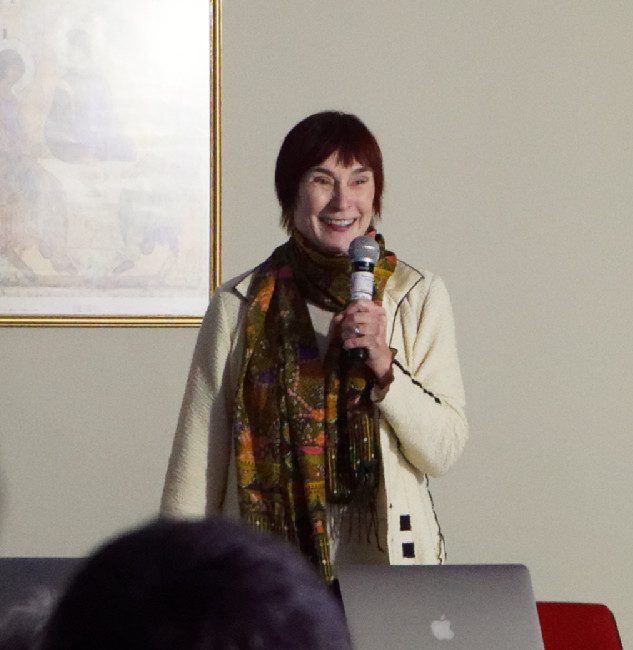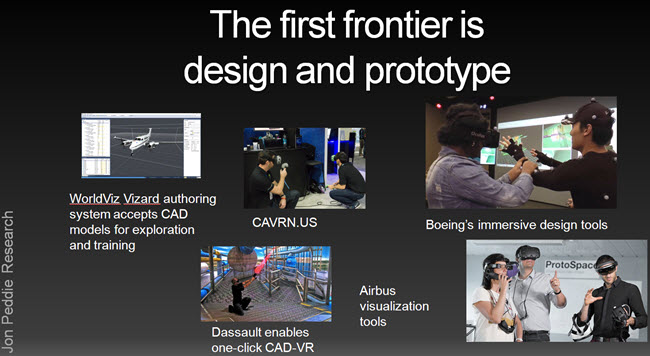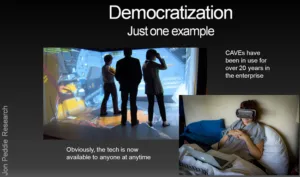Kathleen Maher is from Jon Peddie Research where she focuses on content creation and software and was the first speaker after lunch when she talked about commercial VR. She started by saying that in VR, the software has been trying to catch up with the hardware.
 There has been some use of collaboration and VR using caves and headsets, but ‘the content was stuck in the computers’. In the past and in the early days of Caves, PCs were not connected or networked but there has now been a huge amount of money coming into the cloud. Now, there are amazing possibilities.
There has been some use of collaboration and VR using caves and headsets, but ‘the content was stuck in the computers’. In the past and in the early days of Caves, PCs were not connected or networked but there has now been a huge amount of money coming into the cloud. Now, there are amazing possibilities.
In the CAD industry, it has been a long wish to connect all the groups – but engineers, designers and data managers were often in silos. Even now, there are silos around rendering, for example. At the show in Laval, there are plenty of companies showing technology for collaboration, but practice really lags the state of the art. CAVEs were big and expensive, but now VR allows everyone to have a CAVE and VR is now starting to get into prototyping and other practical applications.
Cave democratisation – we can all have one, now. Image:Jon Peddie Research
Data has migrated to the cloud but ‘OMG that took forever’ and now design is going to the cloud. However, engineers are still often worried about data security and don’t like to have all their data in the cloud. Nevertheless, there is now more interest in doing the work in the cloud and online. Once data and software is in the cloud, VR starts to be easier, she said. Content is going to the cloud and Sketchup, Sketchfab, Grabcad are allowing access to standard content very easily. Why not just license the models, like you do with music, now? With music, you don’t create all your own content, so why do it for engineering?
In VR and collaboration, eye contact can be helpful. Dassault, WorldViz and Carvn.us are working on systems for collaboration. However, big models still have a lot of data and that can be a challenge, still, for example if you want to upload the design for an aircraft!
Training and service is going digital. With CAD and CAM including 3D printing, more and more of the design, development and manufacturing process is driven by the CAD models. We’re getting to the point where this could be done (although it’s not done much, yet). Maher showed a video developed by NCR showing how VR can be used to demonstrate the maintenance and even provisioning of ATMs. Another video showed aircraft design using Caves. Haption and Dassault are working on bringing VR into the factory, with VR for checking the ergonomics of assembly. There are real wins when silos can be broken down. Maher said that Siemens has reported that getting better collaboration between ideation, prototyping and design has saved as much as 30%, already.

However, in VR there is not enough content, yet. For those who say that designing using VR is tricky, she said that design is a difficult process, anyway. Finding IT resources can also be a challenge for SMEs.
A lot of impetus for VR is coming from gaming because of the money in the game industry and tools such as the Unity game engine have even allow the analysis of a car design (Animech). Autodesk bought a product called Stingray for use with 3DStudio Max. The Unreal game engine is widely used and can be used for walkthroughs in professional applications. However, it can still be challenging to make these tools work, so there is still developmet for software companies to do. 5G will mean lots of networking and Moore’s Law will allow ubiquitous computing. The amount of data and the number of models is continuously growing – for example, drones are being used to capture models of cities much more quickly than using other techniques.
“As the pixels flow, the silos break down”
As the pixels flow, the silos break down, Maher said. Everything is networked and although sensors in VR are often seen as separate from the IoT, they are really almost the same. It may also be useful for humans to simply to get out of some situations and ‘leave it to the things’.
Finally, she said, VR is for when you want to go to a different world, but AR is when you want to bring things into the real world.
In questions, Maher said that PTC has bought Vuforia and an IoT company – it’s starting to work on how you design components that can integrate communications and can feedback information on usage and performance.
Responding to a question, Maher said that there is no real winner between Unreal and Unity, and it doesn’t matter as they are different. Both are free to use, but Unreal is easier to start with. Maher said that Unreal models can be very good and one is being used in the Rogue 1 movie – it was good enough for Hollywood. She also said that Unreal is working on allowing more customisation of models and games based on the assets.

